ÇATALHÖYÜK 2003 ARCHIVE REPORT
    |
STAMP SEALS AND CLAY FIGURES
Ali Umut Türkcan
Abstract
Three clay stamp seals and 33 clay figures or fragments of, were recovered in the 2003 season, plus one incised stone. In actual fact the stamp seals represent the first attributable to depositional contexts since the excavations re-started in 1995. Until this last season, we had recovered only 5 fragmentary pieces and one stone incised flat gabbro stone of uncertain sealing function (Archive Report1999). This season two stamp seals of geometric design were recovered from a human burial context, and the third, although incomplete, appeared to be in the form of a leopard which was recovered from an unstratified Neolithic midden context. The incised stone was found unstratified in a topsoil context (8745).
Clay figures were recovered from all areas of excavation in the 2003 season, that is from the new 4040 Area, and on-going areas of BACH, TP and the Chalcolithic West Mound. The vast majority are small fragments only which are hard to identify. Other fragments represent pieces of horn or limb of animals whilst many complete pieces are generally humanoid and animal figurines.
Ozet
2003 sezonunda, üç adet kil mühür, 33 adet kil nesne ya da parçasi ve bir adet oyulmus tas ele geçmistir. Kil mühürler, kazilarin 1995’te yeniden baslamasindan bu yana bir dolgu baglamiyla iliskilendirilebilen ilk örnekleri teskil etmektedir. Bu son sezona degin, yalnizca 5 adet mühür parçasi ve damga islevi belirsiz tek bir oyulmus düz tas ele geçmisti (1999 Arsiv Raporu). Bir insan gömüsü baglamindan ele geçirilen geometrik tasarimli iki damga mühürünün yani sira, katmansiz bir çöplük baglamindan ele geçen üçüncü bir tanesinin, bütün olmamakla birlikte, bir leopar formunda oldugu görülmektedir. Oyulmus tas ise katmansiz yüzey topragi baglamindan (8745) ele geçmistir.
Kil nesneler, 2003 sezonundaki kazilarin, yeni açilan 4040’tan, süre gelmekte olan BACH, TP, ve Kalkolitik Bati höyügüne kadar tüm alanlarini temsil etmektedir. Bunlarin çogunlugu tanimlanmasi güç olan küçük parçalardir. Diger parçalari hayvan boynuzlari ve uzuvlari olusturmaktadir. Bütün olarak bulunan parçalarin çogu ise insan ya da hayvan figürinleridir.
Stamp Seals
The three stamp seals were recovered from the 4040 Area to the north of the East mound. They indicate prominent, and also promising, features in form and pattern. Two were from a Neolithic burial (F.1244). This burial was found very close to the surface and was also cut by a classical period burial. As such it was heavily disturbed and the burials’ context for the Neolithic activity is not yet established. A third seal was from a ‘scrapping’ context over midden deposits and therefore not a sealed context. Despite the lack of secure contexts, the finds indicate a higher occurrence in these late levels that the pottery suggests to be Levels III and later (see Pottery, above).
The individual description of stamp seals of 2003 are as follows:
1) 8813.X1(4040 Area Fig. 59)
The seal was found in a multiple burial F.1244 along with other finds of stone beads, one shell bead (8814.X3), one bear tooth (8814.X2) and a worked bone(8814.X1). The seal was found between the lower jaw and upper chest. The overall form is sub oval with a broken handle through which is a perforation hole observed both in profile and also on the broken apex of the handle tip. The perforation indicates that it belongs to the same group (4. pattern group, see Türkcan 1997 Archive Report and forthcoming publication specialist reports), with two seals from Level II (No.5 in new typology, see Türkcan 1997 Archive Report forthcoming specialist report) and Level IV (No.12 in new typology; see Türkcan 1997, and forthcoming specialist report) of Mellaart’s material. 8813.X1 is a new example from the current excavations which has been added to the typological group mainly formed from the 1960’s assemblage.
The fabric is generally fine to medium. It has some organic charred remains inside the paste. It is medium baked. The outer surface of the handle back part is dark yellowish brown (10 Y/r 4.4), compared to the inner side of the paste (very dark brown 7,5 3/2) probably due to a firing rather than deliberate. Noteworthy is that the grooves of the design are fragile because of heavy firing.
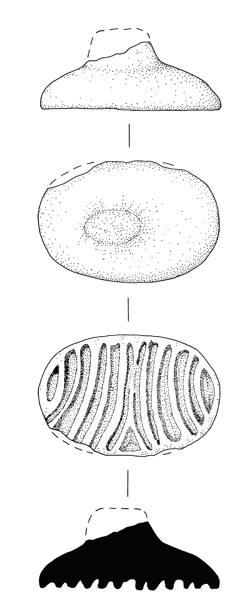 |
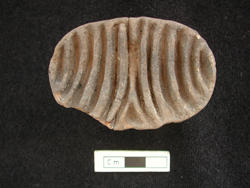 |
Figure 59: Stamp seal 8813.X1
2) 8814. X15 (4040 Area Fig. 60):
This seal was also from burial F.1244. The seal form is like a curving boomerang with curved edges and rounded ends. The same form is repeated on the design side with deep cut out carving. The overall seal form is similar to a boomerang shaped seal (7. form group, see forthcoming publication in specialist reports). The handle form is elongated and conical .
The fabric has a mineral temper. It is medium to well fired, and oxidised in some parts. The surface is very smooth and well finished. The fabric resembles that of Last’s Group 3 pottery mineral tempered fabric. The handle is light brown (7,5 YR 6/4). The seal face appears to be the same colour but is lighter in tone (7,5 YR 6/3). On the back side, there are some small white porous residues probably due to tiny pebble fragments inside the temper.
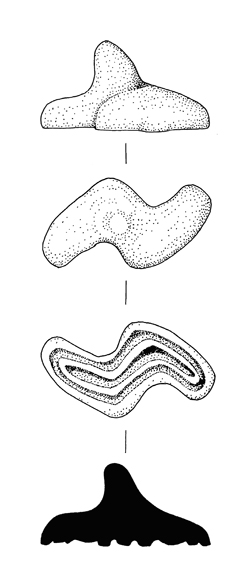 |
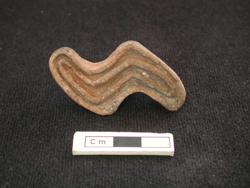 |
Figure 60: Stamp seal 8814.X15
3) 8805.X2 (4040 Area Fig. 61)
This is one of the most extraordinary pieces depicting a possible leopard. Of the assemblage found to date naturalistic renditions have taken the form of a simple ‘hand’ shaped stamp seals. This possible leopard form has an almost 3-dimensional quality with modelled features similar to figurines. The seal face has been rendered in order to show a standing leopard in a natural way. It is the first of this form type not only from Çatalhöyük but also across the Neolithic period in Anatolia.
The depiction form shares the same iconography with some wall relief’s as found by Mellaart (see Fig. 61). This common use of same patterns (or symbols) is already seen in floral designs and the hand form. Both patterns are seen on wall paintings and Early Chalcolithic painted wares from Hacilar. It shows that these are common symbols of the community through generations and they indicate a deliberate selection of symbols rather than representing random patterns.
The seal face as mentioned, is modelled in a leopard form with a surface ornamentation that depicts leopard spots. The spots of the animal are made by cutting out roundels, even along its tail that lies along the animals back. The head and the forelegs are missing.
The fabric is sterile and does not include any temper. It is almost entirely oxidized on its outer surface due to the firing process. The seal face however, is not oxidised (probably turned upside down and flat on the surface during the firing process). The core paste is grey. The outer colour of the handle is partly dark grey (10 Y/R 4/1), the seal face is light grey (10 YR 7/2 ).
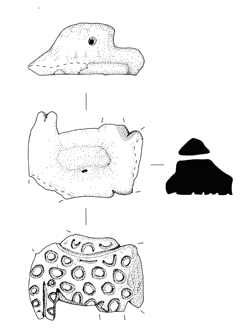 |
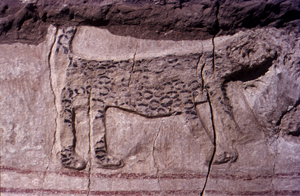 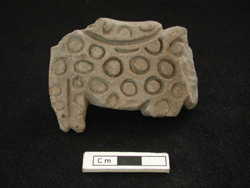 |
Figure 61: Stamp seal 8805.X2 & an example of leopard wall relief excavated by Mellaart in Shrine VIB.44
Human/Humanoid Figures
Human-type figures are in some ways (or in some examples) hard to describe, and represent a broad range of typology. Almost all are recovered damaged, fragmented and broken before their deposition. Human figurines are (especially small ones) hard to identify. For this reason, some figurines which are hard to identify as human or can not be differentiated from human features, are described as humanoids. The term was first put into use by Hamilton (1996) and will be used in the following study. The term has also been retained in order to be in accordance with the terminology previously used and to avoid terminological confusion.
Five pieces of complete or nearly complete human/humanoid figurines were recovered during this season. These are as follows:
8628.X1: Clay face with chipped nose broken from the neck (BACH Area Fig. 62)

Figure 62: 8628.X1
7770.X2: Humanoid Head Part (BACH Area): This has a slightly protruding nose, the mouth and eyes have been emphasized by small dot-like incisions. It is made of clay. (21 mm H., 18 mm. W)
8749.X1 (4040 Area): Headless sitting female figurine. It has a slightly swelling stomach and breasts. One arm is missing. Other arm looks like slightly folding but it is hard to identify due to its damage. It is in a sitting position, which is why the legs have not been shown. The head part seems to have broken from the body before deposition of the figurine.( 31mm. H., 20 mm W.)
7814.X1(TP Area, See Fig. 29). Small female figurine that is made of green stone. It is complete and the torso has been carefully carved. No facial features have been rendered. (16mm. H, 8mm. W)
Animal Figurines
Ten complete animal figures were recovered this season of which 5 are bird representations, 2 are quadroped animal figurines (possibly cattle forms). One is a wild boar head with a hooked nose. The last one seems to be nearly complete, but it is hard to identify due to damage on its frontal side.
Some individual descriptions of diagnostic animal figurines are as follows:
8795.X3: (4040 Area) Relatively big clay quadroped animal figurine, probably cattle but the horns are missing. It is heavily fired and was broken in many pieces but now conserved (55m L, 23 mm W., 59mm. H.)
8761.X3: (4040 Area) Relatively big clay quadroped animal figurine, probably cattle but head part is missing and the frontal side has been very damaged (41 mm L.)
7905.H1: (4040 Area) Small stone sitting bird figurine (12 mm H.)
9023.X7: (West Mound) Small marble figurine head, the body part is missing. The face recalls a big reptile (or a feline?). The facial features have been emphasized by two long deep incised lines (mouth and eyes) running parallel to each other on the profile. The neck part has been also emphasized by a deep carving round the neck.
8624.X1: (BACH Area) Clay bird? It is nearly complete, only the legs (?) are slightly broken. It has a protruding nose. Beyond that any facial feature is hard to distinguished, only very shallow curving like eyes. This type, found in large and small sizes, is one of the major typological groups. Often called ‘bird-man’ because of some humanoid features (protruding nose, long thick neck part, emphasized legs in some examples) (38mm H., 18 mm W).
Miscellaneous
9036.X4 (West Mound, See Fig. 44): Upper part of a ceramic anthropomorphic jar. Although the piece originally belongs to a jar, it may have also been used as a figurine as it is very worn around the upper neck rather like the base of an object such that it stands on a flat surface. Beyond its striking secondary function as a figurine, it is very similar to a Hacilar IV Early Chalcolithic anthropomorphic jar (Mellaart 1974: 111, fig.96; 1975: 118, fig.69). The piece is painted with red ochre bands on a cream colour surface. It has two openings (probably as its function as a jar), one on the top of the head, and another at the front of the neck slightly below the face (76 mm H, 59 mm L., 62 mm. W.)
8745.X1 (4040 Area, Fig. 63). This is an incised stone from an unstratified context during surface clearance of the 4040 Area. Both sides are flat however, one side is more flattened and is patterned in a symmetric arrangement of drilled grooves and incised wavy lines. The drilled grooves are set in 3 parallel bands with parallel incisions covering 3 parallel grooves side by side. On the reverse side are scored 10 shallow parallel bands. Although, these shallow parallel two pair of 5 bands seems to create a pattern scheme, it is much probably beyond being any elaborate pattern. They may be scratching of some unknown marks. The material seems to be dark green gabbro, but a detailed material analysis is forthcoming. The overall condition is good but one corner is slightly broken and worn (9mm H, 54mm W, 32 L).
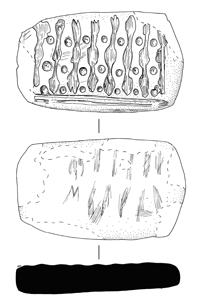 |
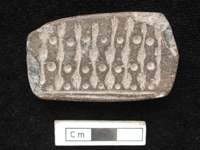 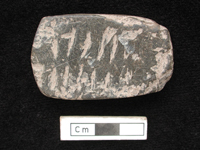 |
Figure 63: 8745.X1
Another similar find is a stone find from Unit (5212) in Space 182, Building 17 of Level IX from the 1999 season. This is a dark green gabbro stone of which one side is carved with line and dot patterns as seen in baked clay stamp seals. The reverse side, which is also flat, but slightly curving, has been also scored with long parallel scratch lines.
7654.X1 (TP Area, See Fig. 30). This is a large baked clay fragment of a square with an uncertain function and form. However, its cubic square form recalls baked clay pot stands that are mostly found in the Early Chalcolithic settlement on the West Mound. It is unfortunate that its damaged situation prevents us to make its original reconstruction. This unique clay piece with its square cubic form has been incised with interesting patterns. The sides are ornamented with pseudo-pattern composed of pairs of interlocking lines that step across at a 45? angle. Every point at which pairs of interlocking lines meet is filled with a dot, similar to the majority of the clay stamp seals and similar finds. The other third face has been ornamented with an unidentified animal pattern (that may be a vulture figure but not certain) (56mm H, 66mm L, 56 mm W). To note, the sides incised with pseudo-meander patterns, share similar patterns with stamp seals.
The remaining 19 fragments that make up the 2003 assemblage are generally fragmentary pieces that are either small horn fragments or other unidentified amorphous pieces.
    |
© Çatalhöyük Research Project and individual authors, 2003